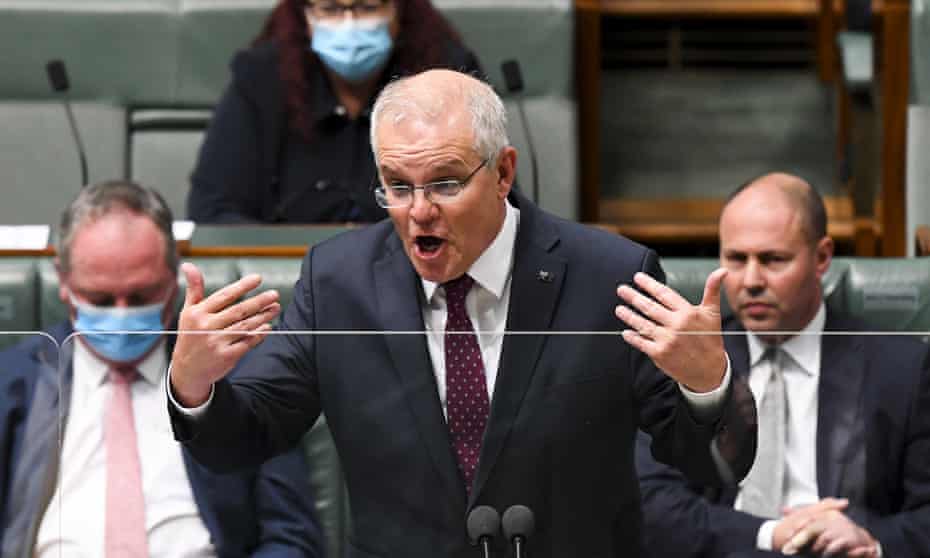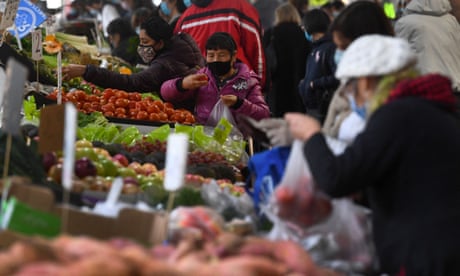Extract from The Guardian
Final sitting weeks are often chaotic – but this hit new heights. After ‘shut up or we’ll lose the election’ failed, ‘we’re not drones’ became the new reality.

It certainly was vibrant. Morrison’s horror week included two government senators on strike until he did something about mandatory vaccinations; George Christensen sanctioning civil disobedience and Russell Broadbent likening vaccine compulsion to criminality; Christensen crossing the floor on a government bill to vote with Labor; Bridget Archer teaming up with Helen Haines to bring on debate about an integrity commission; moderate Liberals digging in their heels on the religious discrimination bill, blunting Morrison’s options to weaponise the proposal against Labor; Liberal China hawks blasting a “retrograde” move by the environment minister to scrap a proposal for a 2.7km concrete runway at Australia’s Davis research station in Antarctica; and peak farce: Morrison at war with Morrison over whether he told Anthony Albanese he was off to Hawaii in 2019.
Final sitting weeks are often chaotic, but the dissonance hit new heights. After “shut up or we’ll lose the election” failed, and “we’re not drones” became the new reality sanctioned by the talking points pack, Morrison dug into the back catalogue to minimise political peril.
This noise was all Canberra bubble stuff. Out in the real world, nobody cares about what happens in the parliament apart from that parliamentary obsessive Albanese, who eats parliament for breakfast and bores the pants off everyone with his arcane procedure. Nothing to see here. All games and theatre.
What have parliaments done for us lately? Hmm, yes, inspiring stuff. Never mind the inconvenience that Morrison is paid by the taxpayer to be (wait for it) a parliamentarian. He’s in fact the most powerful parliamentarian in the country. Fun fact. Democratic institutions, and core conventions like resolving conflict through deliberation, are what stands between us and autocracy or chaos. But by all means, collect the salary and disdain a goodly part of the job description.
In any case, it would be helpful if the prime minister could get his story straight. In Morrison’s other improvised flourish of the week, posturing bubble-dwellers were cast as the heroes of the side. The prime minister felt voters would be deeply distressed if federal Liberal politicians were humiliated by a nasty boyfriend surveilling anti-corruption body. Morrison felt public representatives were people of standing who did not deserve being done over by a kangaroo court (although it seemed to be OK for Icac-style bodies to do over Labor politicians because they had it coming).
It really was hard to keep up. In any case: here’s my statement of the obvious. Morrison’s shapeshifting and sandbagging is gratuitously self-serving.
But that doesn’t make his diagnostics wrong.
Morrison is correct to note that much of the intrigues and embarrassments of the week won’t have registered at a granular level. Only highly engaged voters monitor events in the parliament closely, and most of them have already picked a side.
Some in the government think they need another budget to turbo-charge the re-election pitch. But this reasoning is odd at a few levels: real people (if readership numbers are a reliable guide) don’t care about budgets as much as they once did. They aren’t really a focal point.
Waiting for a budget also pushes the election closer to winter. Morrison wants to run on how good is freedom. Let’s get government out of people’s faces. That’s a summer campaign, not a winter one given what’s happening in the northern hemisphere – Australia’s higher vaccination rates notwithstanding.
Labor thinks it is in this political contest. The polls bear this out. But Morrison, despite all his current problems, has a structural advantage. Labor lost badly in 2019, and in the absence of a 2007-style ‘vote the bastards out’ groundswell, it will be hard to win enough seats to win outright.
Things are promising for Labor in the west. People say things aren’t toxic in Queensland, but the legacy of 2019 is big buffers in Coalition-held seats. New South Wales could be patchy. Palmer’s United Australia party is making inroads in the state after the long lockdown, according to our Guardian Essential poll, and Nationals are hunting in the Hunter.
Tasmania will be important. Archer crossing the floor this week suggests she’s more worried about her constituents than Morrison’s desire for tranquility. She holds the marginal Tasmanian seat of Bass. Jacqui Lambie declared at one point during the week the Coalition was in deep trouble in Tasmania, but it’s hard to know which way the wind is blowing, given those marginal seats flip from election to election.
Both sides think a hung parliament is a genuine possibility, hence all the oversized focus on independents targeting government-held seats, even though this insurgency is a handful of seats phenomenon.
While the focus has been on Morrison’s travails, the coming few weeks are also very important for Labor. Albanese has worked hard for months to persuade voters to question Morrison’s character. But as the election creeps closer, Labor needs to flesh out its own policy agenda.
Either next week or early the week after, Labor will resolve a critical element of its climate policy – a new medium-term emissions reduction target.
Labor’s progressive base will want an ambitious commitment. But climate policy ambition isn’t an electoral plus in all parts of the country. The Coalition is still actively recruiting votes from workers in traditional carbon-intensive industries. The government will weaponise an ambitious medium-term target in regional Queensland and NSW.
The Coalition’s target is a cut of 26-28% by 2030. Labor is considering a target somewhere between 35% and 45%. The most recent government emissions projections forecast overachievement on the Abbott-era target, with a likely reduction of 35%.
The projections give Labor political cover to promise a cut of 35%. But the science would say go harder. So the shadow cabinet will mull options up to 45%, which could involve Labor engaging the Coalition’s own safeguards mechanism to drive lower abatement during the transition to the new energy economy.

The shadow treasurer, Jim Chalmers, is from Queensland, the state that swung heavily against Labor in 2019. On my podcast this weekend, Chalmers says Queensland has been typecast unfairly as knuckle draggers in the climate wars.
Chalmers says people in regional Queensland remain anxious about the transition so they won’t cop significant ambition without concrete assurances about jobs. He says people are also sick of the political divisions about climate policy. Nuanced listeners in the LNP report similar sentiment. Voters see a problem, and they want politicians to shut up and fix it.
Chalmers says the Queensland government has given Labor a working template for linking ambition with long-term job security. Targets need to be accompanied by government investment in “additional jobs, additional industries”.
“If you look at the Palaszczuk government, they’ve made some really quite remarkable investments in Gladstone in hydrogen, in Townsville, in other minerals,” he says.
Imposing ambition and aligning that with investments in new economic opportunity allows people to see “tangible opportunities in regional communities”.
“I think that’s the way through this issue.”
Albanese, who is daring to hope Labor can catch a wave, will be hoping that’s the case.
No comments:
Post a Comment